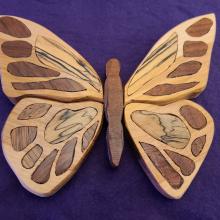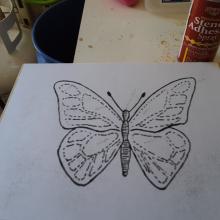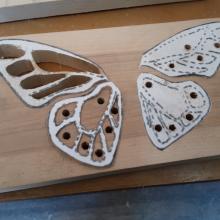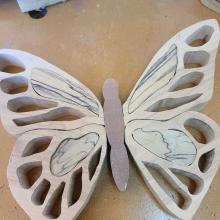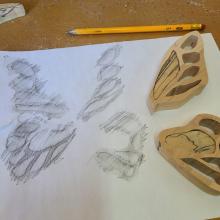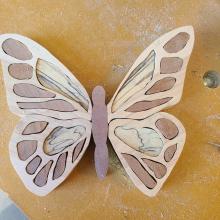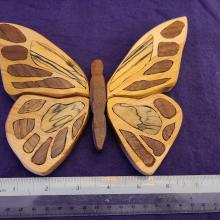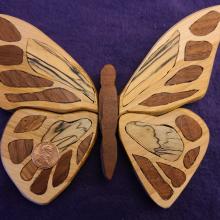Siena, Italy is considered the birthplace of intarsia. Often thought to be widely popular in the 15th & 16th centuries, there is evidence of intarsia as early as 12595. Domenico di Nicolo (1342 – 1453) was a master and most famous intarsia artisan. He worked for 13 years on the chapel in the Palazzo Pubblico at Siena and the doors of the Sala di Balia.
In period, artisans would have cut their intarsia pieces using a fret saw. For my first attempt at intarsia, I chose to not use a fret saw since I have back issues that would have made using hand tools difficult for sustained periods of time. Instead, the primary tools used included a scroll saw and multiple sanders.
My first mistake was choosing a pattern with very small pieces (some of the wing’s dots are the size of my fingertip). This made cutting and sanding such small pieces difficult and a safety hazard. I began cutting each piece, beginning with the wing’s framework. This was my second mistake. By cutting the framework first, it made fitting the wing’s dots very difficult. Many attempts were made to get each dot to fit just right. The third mistake was in the layout of the wood pieces. I should have paid more attention to the direction of the grain prior to cutting each wing dot to ensure the grain matched the contour of the wings. This was an aesthetic flaw by an amateur but easily remedied next time.
Cited Sources:
- Britannica, T. Editors of Encyclopaedia. Inlay. Encyclopedia Britannica. https://www.britannica.com/art/inlay
- Britannica, T. Editors of Encyclopaedia. Marquetry. Encyclopedia Britannica. https://www.britannica.com/art/marquetry
- Rogers, L. R. Sculpture. Encyclopedia Britannica. https://www.britannica.com/art/sculpture
- Britannica, T. Editors of Encyclopaedia. Intarsia. Encyclopedia Britannica. https://www.britannica.com/art/intarsia
- F. Hamilton Jackson, The Project Gutenberg EBook of Intarsia and Marquetry, 2009. https://www.gutenberg.org/files/30215/30215-h/30215-h.htm
- The History of Intarsia. https://web.archive.org/web/20061108174831/http://www.tbirdranch.com/In…
- Scroll Saw vs Coping Saw vs Fret Saw. https://www.youtube.com/watch?v=XN7UC1AXpcs
Additional Sources:
- Jordano, Á. (2012). The Plus Oultra writing cabinet of Charles V: Expression of the sacred imperialism of the Austrias. Journal of Conservation and Museum Studies, 9, 14–26. DOI: http://doi.org/10.5334/jcms.91105
- Marquetry and Intarsia. Fundamentals of Woodworking. https://www.fundamentalsofwoodworking.com/woodworking-resources/Woodworking-Articles/marquetry-and-intarsia
- Kathy Wise. Intarsia, Woodworking for Beginners. 2009.

